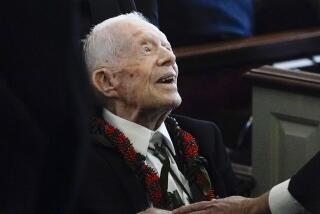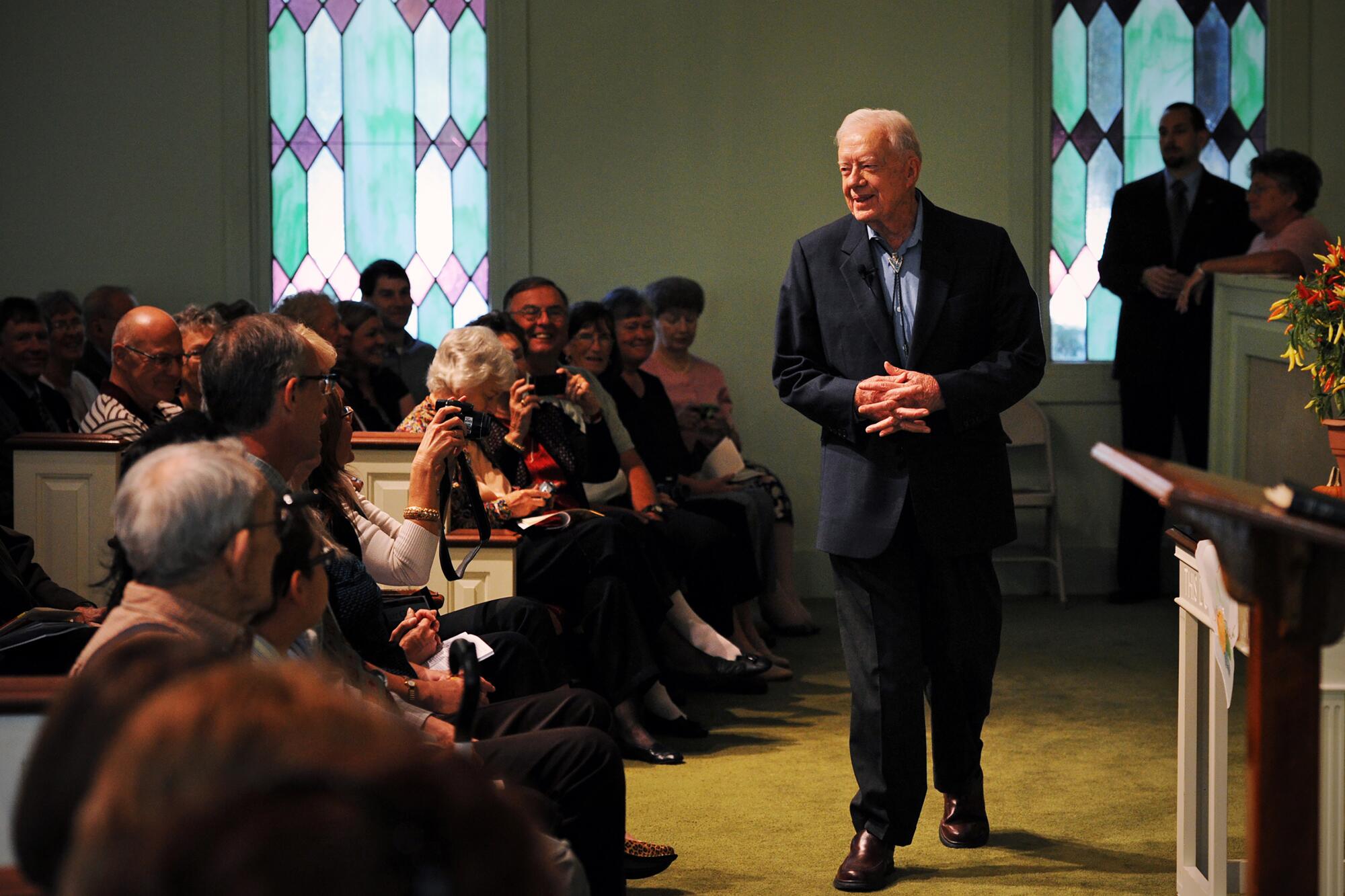
Reporting from Plains, Ga. — In the wee hours of a crisp, wet fall morning, hundreds of cars drove slowly over a dirt path in this tiny rural town then parked among a grove of trees. The occupants exited to line up in leisurely fashion to hear a man who would soon become one of the newest Grammy Award nominees.
Newest, perhaps, but hardly the youngest.
In fact, this nine-time nominee and two-time winner ranks high on the list of contenders for the title of oldest Grammy nominee in history — all the more notable for someone who doesn’t so much as sing, hum, strum, pluck, pound or otherwise operate a musical instrument.
Instead, former President Jimmy Carter’s latest Grammy nomination is in the spoken word category, this one for the audio version of his 32nd book, “Faith: A Journey For All.”
Former President Jimmy Carter, who won in the spoken word category for the audio recording of his latest book, “Faith: A Journey for All,” will walk away from Sunday’s Grammy Awards ranking No. 3 on the list of the oldest winners in Grammy history.
At 94, the nation’s 39th chief executive is impressively active. Among his many post-presidential duties, one of those closest to his heart is speaking every other Sunday at his hometown church in Plains, Ga., population 727 as of 2017.
Over Veterans Day weekend, his early November talk fell on the holiday, making the day that much more resonant given his service in the U.S. Navy shortly after World War II.
The website for the Maranatha Baptist Church in Plains advises visitors to arrive before 5:30 a.m. to get a seat in the church’s main sanctuary where Carter speaks. But by 5:30 a.m. on this weekend, nearly 100 cars had already arrived, and more were slowly finding their way through the pre-dawn darkness. By conservative estimate, more than 400 people had made this trek, some covering thousands of miles, for the opportunity to visit with an ex-president.
In the nearly 40 years since he lost his bid for a second term, Carter’s stature has grown for the in-the-trenches work he and former First Lady Rosalynn Carter — he proudly mentioned they’ve been married 72½ years — have done with Habitat for Humanity and as an ongoing ambassador of U.S. goodwill.
On a far more modest scale, he uses his fame to support the church he helped establish in 1977, in part because local churches were less than inclusive at that time. (“The churches have been the last bastions of having white and black separated,” the former president noted during his talk.)
The process for entering the building is rigorous, and all are wanded by Secret Service agents before setting foot inside.
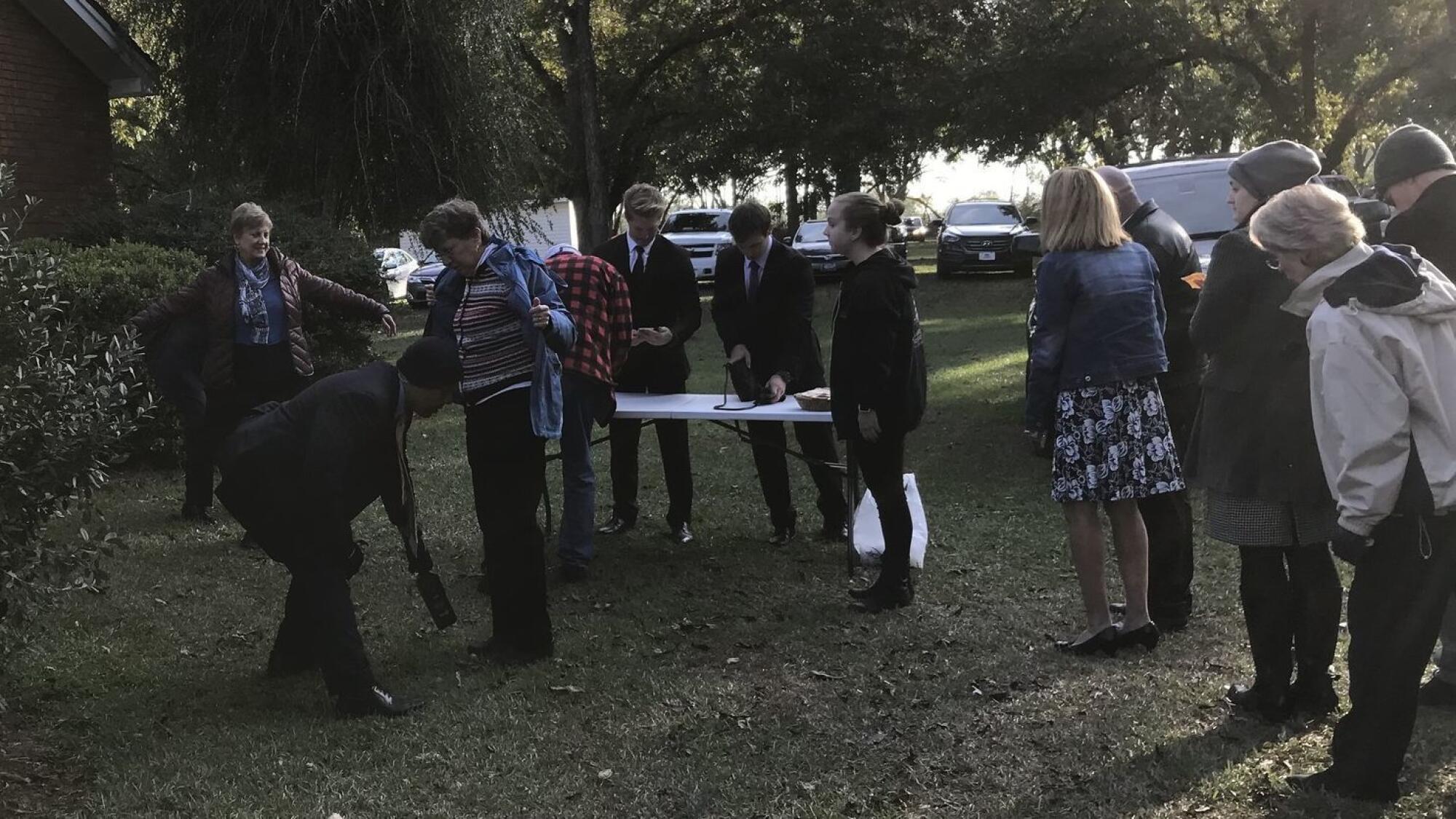
Those who arrived hours earlier — some began lining up around midnight — snagged the best seats in the church’s modest sanctuary, which faces an altar on which a simple wood cross hangs.
It’s one of several pieces in the church made by the former president himself, along with gorgeous wood collection plates. They’re signed with his initials, “J.C.,” which elicited smiles or double takes from many visitors as a sample was passed around the room.
Those who couldn’t find seats in the sanctuary were ushered into the church’s utilitarian overflow room, which was standing room only and equipped with a video screen that would relay his talk. The difference between the turnout for a Jimmy Carter Sunday and a non-Jimmy Carter Sunday is striking. The Veterans Day program included a report on the previous week’s attendance: regular congregants: 27; Visitors: 14.
Carter’s niece, retired grade-school teacher Kim Fuller, alerted visitors on the morning’s protocol: Do not applaud when he enters the room. (“He hates that,” she said.) Also, she said, visitors he might call on should address him as “President Carter” — not “Mr. President” (a title reserved for the current occupant of the White House), and certainly not “Jimmy,” a privilege requiring a degree of familiarity most strangers haven’t earned.
Around Plains, she explained, Carter’s friends and neighbors commonly refer to him as “Mr. Jimmy.”
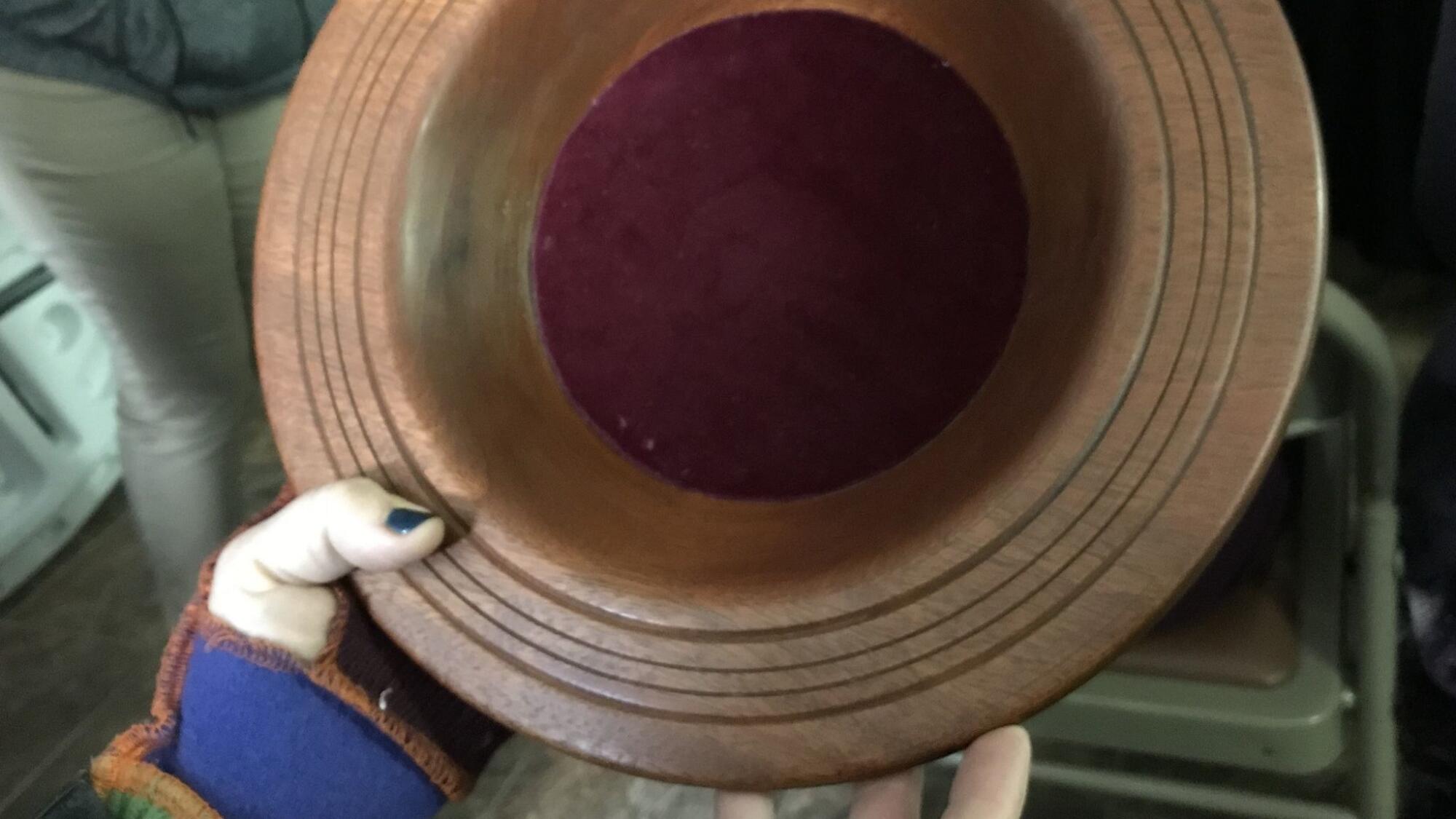
His talk was set to begin at 10 a.m., but around 9:15, without so much as an introduction, a door at one end of the overflow room popped open and Carter stepped in quickly to greet the crowd before his scheduled talk in the sanctuary.
“Good morning,” said Carter, dressed in a modest green suit and white shirt gathered at the neck with a bolo tie of Navajo design.
“How did Kim do?” he asked. “Did she do OK?
“If you want to hear a real Sunday school teacher, come when I’m not here, when she’s teaching,” he said, flashing the toothy smile that’s an integral part of his folksy charm. When, as governor, he campaigned for the nation’s highest elected office more than four decades ago, he typically introduced himself with that broad grin, and the signature introduction, “My name is Jimmy Carter, and I’m running for president.”
Still in introductory mode, Carter pointed out one of the higher profile visitors in the crowd: Stuart Eizenstat, who served in numerous political positions under four U.S. presidents, including his term as Carter’s domestic affairs advisor, an assignment Eizenstat has drawn on in his recent book, “President Carter: The White House Years.”
“When I need to find out what I did when I was president — and I say that without exaggeration, because it’s really honestly told, I go to Stu Eizenstat’s book,” Carter said.
‘We told the truth’
James Earl Carter Jr. was elected president in 1976 by ust less fewer than 1.7 million in the popular vote, winning the electoral college handily with 297 votes to President Gerald R. Ford’s 240, leaving Ford the only person ever to serve as president without having been elected to that office or the vice presidency.
Carter’s campaign was built on bringing integrity back to the White House, two years after Richard Nixon avoided impeachment by resigning in the wake of the Watergate scandal.
But Carter’s popularity soon took a beating when the Middle East oil shortage of the late ’70s caused gasoline prices to skyrocket. Even more damaging to his legacy was the international crisis over U.S. hostages taken during the 1979 Iranian Revolution that ousted U.S.-backed Shah Mohammed Reza Pahlavi.
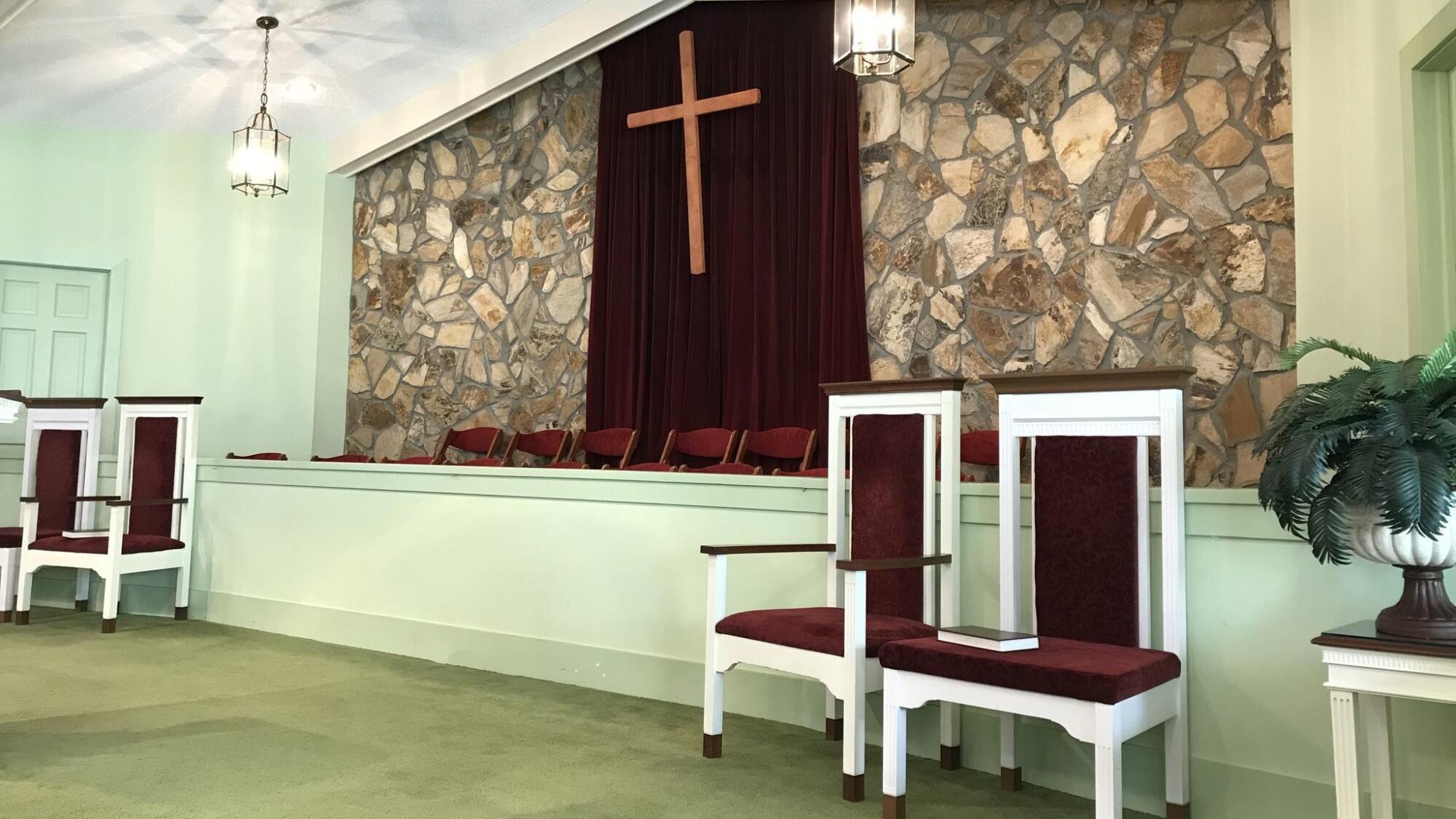
A failed rescue operation in 1980, during which eight Americans and one Iranian civilian were killed, only exacerbated criticism of Carter, who also was hammered as inflation shot from 4.6% in 1976 to 12.5% during his final year in office, after cresting at 13.3% a year earlier, according to government figures.
After a landslide victory for Ronald Reagan in the 1980 presidential election, the remaining hostages were freed on inauguration day, Jan. 20, 1981.
Despite its challenges, the Carter administration passed more legislation than any other dating to Lyndon B. Johnson. An exhibit on his presidency at the Jimmy Carter High School Museum in Plains, housed in buildings where he attended high school, notes that he appointed more women to political positions than all previous presidents combined.
Among many quotes on display throughout the Carter Museum, about 150 miles almost due north of Plains, is one short and pithy summary of the Carter administration’s legacy as delineated by his vice president, Walter F. Mondale: “We told the truth. We obeyed the law. We kept the peace.”
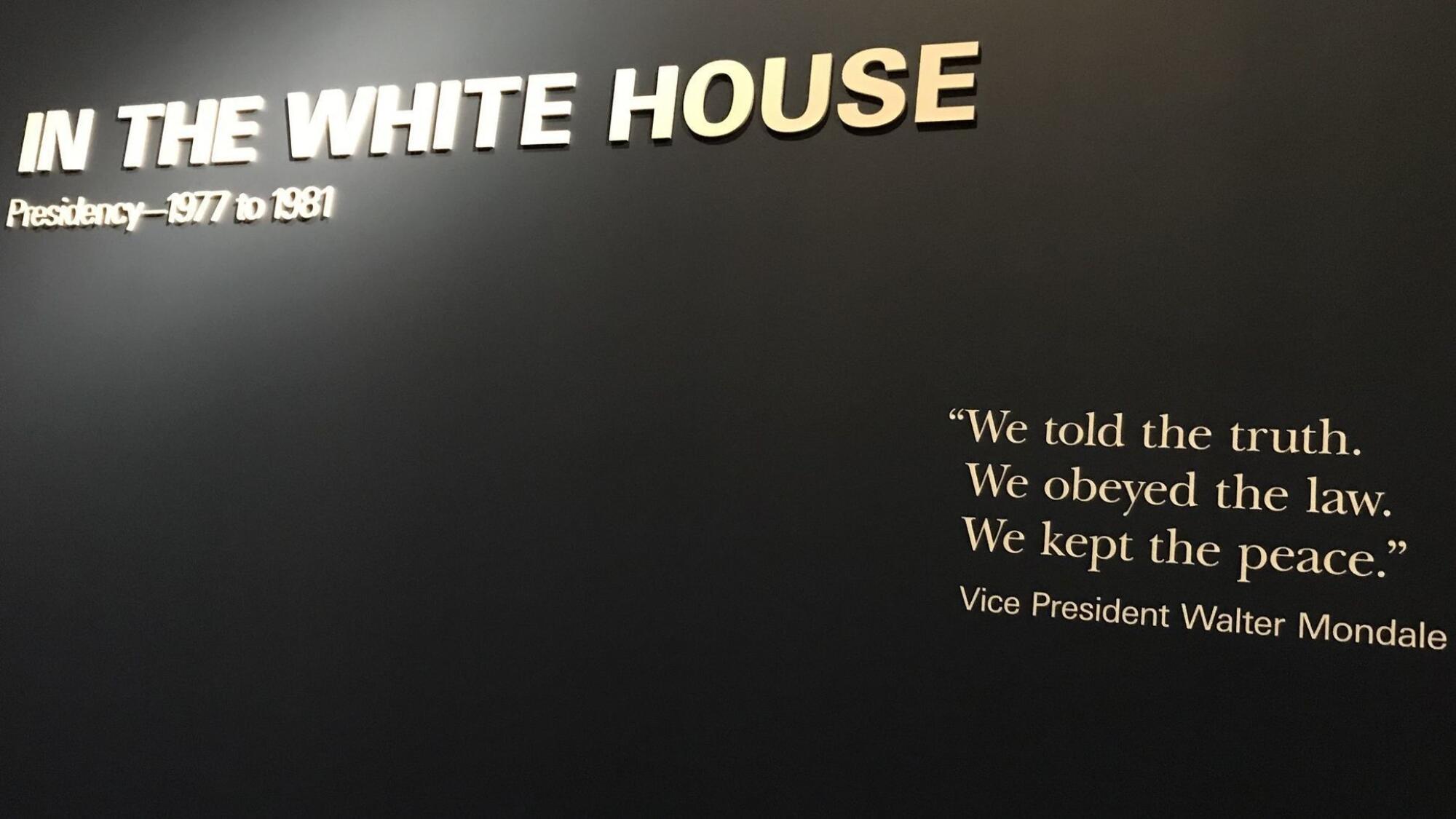
‘It’s about love’
As is his custom when he speaks in church, Carter conducted a quick survey of the far-flung places visitors have come from.
“I like to know whom I’m teaching,” he explained. “If you’re here for the first time…let me know what state or country you’re from.”
A visitor sounded off: “Washington state!”
“That’s where the best submarine in the world is located,” Carter answered quickly, then repeated the names of locations others offer up: “Florida…Illinois…North Carolina…Indiana…Texas…Mexico...Croatia...Turkey...Malaysia...India…Nepal...Nigeria…OK, very good, we have a lot of projects going in Nigeria....I went to Nepal three times in one year. I wasn’t climbing mountains — I was trying to hold elections.”
One of the signature missions of the Carter Center in Atlanta — which the couple created in 1982, shortly after moving home to Plains in 1981 — was to observe elections in various countries to help ensure that they are carried out democratically. Since 1989, the Carter Center has sent teams to points around the globe to monitor more than 100 national elections.
Following the geographical survey of his visitors, he cut to the chase and asked those on hand to identify key issues they thought the world will be grappling with over the next decade.
It’s something, he said, that helps in setting long-range goals at the Carter Center, which targets a few issues at a time, ones on which the Carters think they can have a real impact.
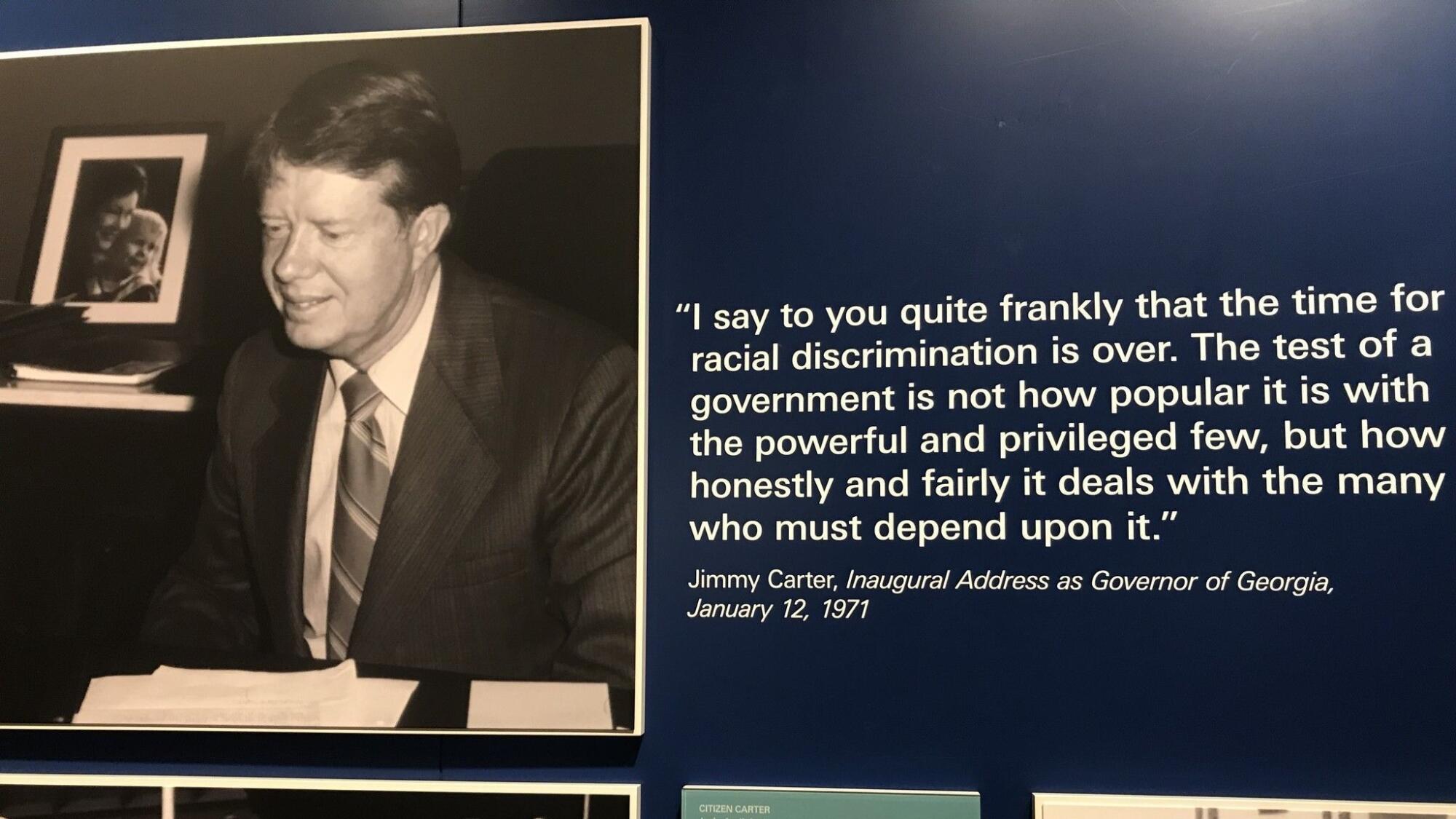
Among the issues enumerated by Carter during succinct, astute exchanges with the morning’s churchgoers: a global rise in nationalism and authoritarianism; a weakening of democracy; nuclear proliferation; climate change; election meddling; rising expressions of racial and religious bigotry; income inequality; disease in third-world countries; cyber warfare and mental health — the latter, a longtime special interest of Rosalynn Carter, who made that her primary focus during her years as first lady.
In addition to election monitoring and proselytizing for better treatment of people with mental health issues, the Carters have also worked to provide clean drinking water in communities in many Third World countries, and their longstanding work with Habitat for Humanity continues to this day.
He credited Habitat founders Millard and Linda Fuller for changing his and Rosalynn’s lives and told the congregation that, the Fullers’ son, Chris Fuller, had been invited to deliver the morning’s formal sermon following Carter’s talk.
“Over the last 35 years, we’ve worked with about 100,000 different volunteers, and we have helped to build, with volunteers, over 4,000 houses,” Carter said of the homes sold interest-free to low-income buyers. “Habitat now is building or completely renovating a house every 55 seconds. So listen: Every minute, somewhere in the world, Habitat for Humanity is building or completing the renovation of a house.”
After about 20 minutes of quizzing visitors and discussing national and international affairs, Carter turned to the topic of the morning: the Old Testament book of Ruth.
“Is Ruth about a history of the Jewish people?” he asked, and quickly answered, “No. Is Ruth about theology? No. Has Ruth got a bunch of Commandments in it? No. What is it about?”
A voice piped up: “Love.”
Carter nodded: “It’s about love,” he said. “That’s true.”
He delved into themes touched on in the book of Ruth, commenting on how they relate to his life with Rosalynn before concluding, “It’s mainly about love and obligation and doing your duty to God.”
During the entire talk, he made no direct reference to President Trump, whom he described as “a disaster” in an interview last year with the Washington Post.
But he did ask of his audience, “How many of you believe the United States will be able to correct our mistakes in the future?”
Few hands went up.
“I do,” he responded even-handedly. “I believe that. And why do you think that is?
“The United States is made up of people — except for Native Americans — who came here,” he said. “Our ancestors, and every one of us who came here from a foreign country, kind of took a chance, right? Because we wanted a better life; we wanted freedom to worship the way we wanted to or something like that.
“We are kind of a conglomerate country of people who are innovative and willing to take a chance, entrepreneurs, and we try new things, and we’re willing to make a change, right?” Carter asked. “Our ancestors proved that, and some of us have inherited those genes.
“So I would say that we are OK in the United States,” he said. “We’ve got a great country, and I think, almost unanimously, Americans have a kind of an innate sense that because of our ancestors and other reasons, we think we can correct our mistakes. Sometimes, we’re just a little slow doing it.”
Scattered applause greeted the end of his talk, and he shook his head, saying, “No, don’t do that.” Instead, he invited visitors to stay for Chris Fuller’s address, holding out the carrot that helped draw many to this remote site: “After church is over — we’ll have a good sermon, I’m sure — Rose and I will be having photographs with everybody.
“We’ll be delighted….,” he began, his voice trailing off. “I started to say, ‘We’ll be delighted’,’ ” he paused. “We’ll be willing to have photographs for everybody.”
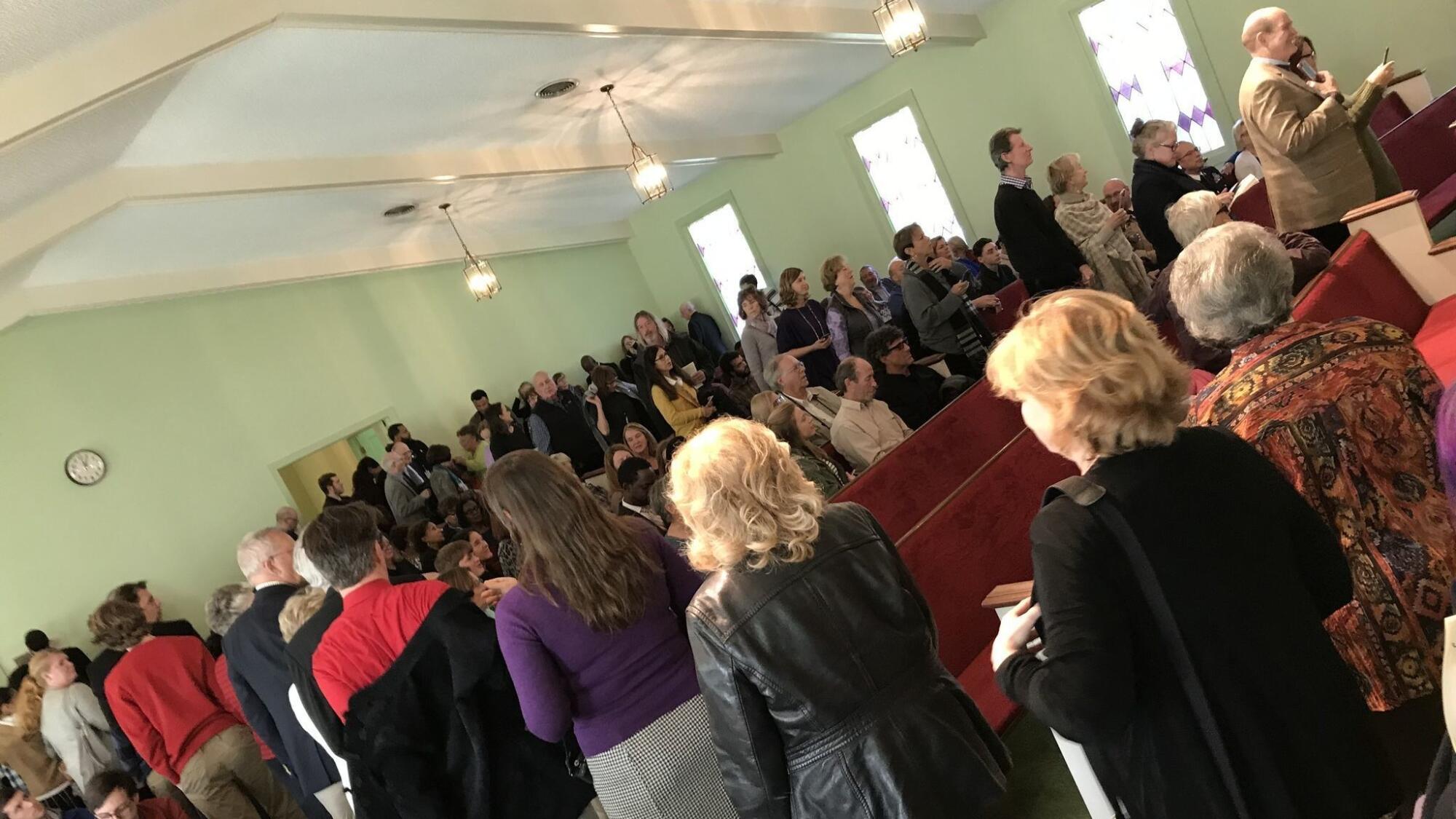
The room erupted in laughter. “We’re very glad you came,” he quickly added, smiling again, “and we will be glad to have photographs for everybody.”
True to their word, they sat in tall chairs, side by side — Rosalynn, 91, at her husband’s right — at the front of the sanctuary for more than 45 minutes as individuals, couples and entire families shuffled through a line to flank them for happy snaps taken on their own cameras and cellphones by Kim Fuller or other church personnel.
After the day’s final photo, they held hands and ambled together out a side door, stepping up into one of the two Secret Service SUVs waiting to take them back to their compound less than two miles away.
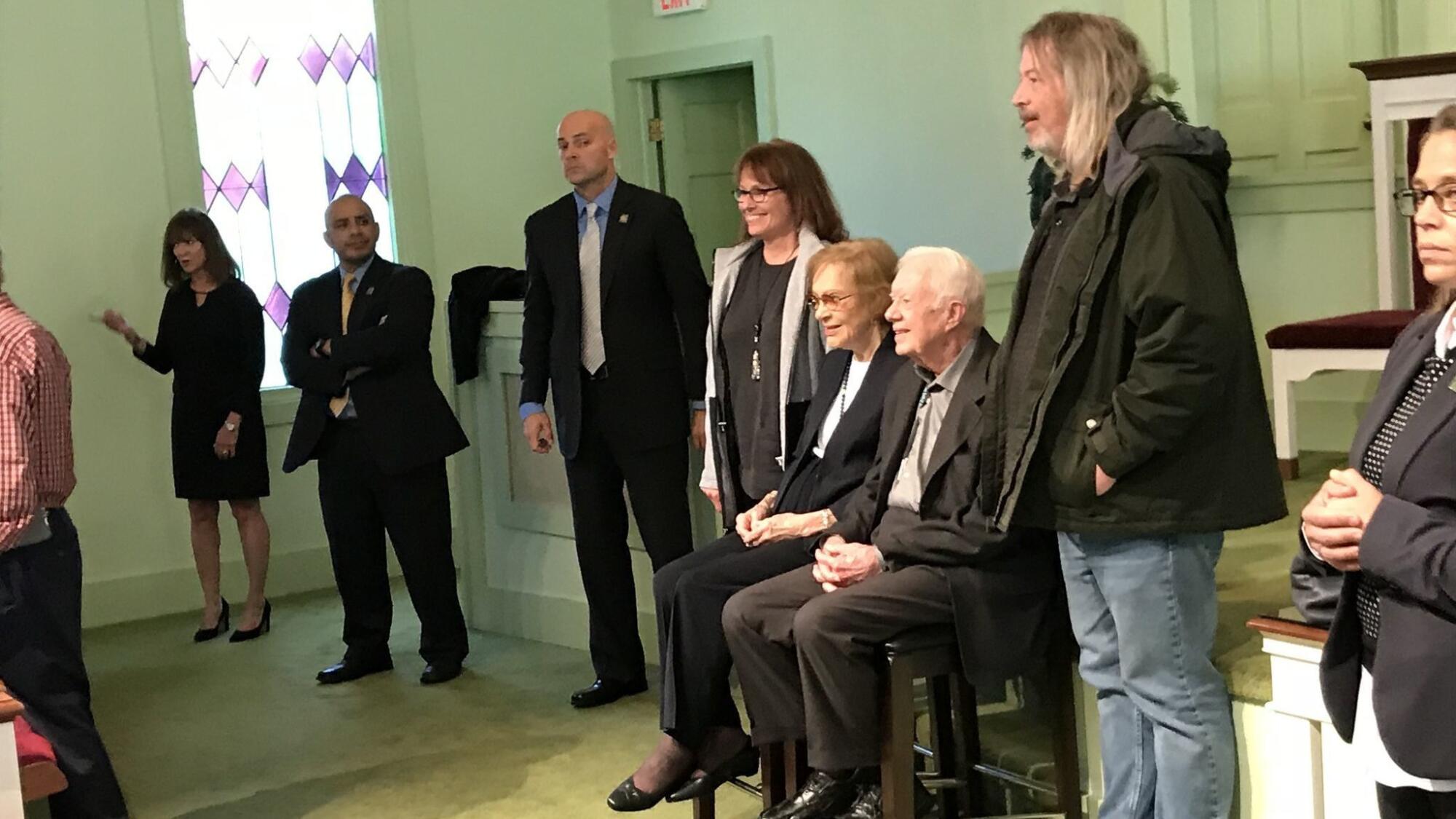
Along the route home is a 13-acre land parcel the Carters donated in recent years for a solar farm that provides electricity to 200 houses in Plains. It’s another program Carter championed during his presidency, when he had solar panels installed at the White House as a visible reminder of one potential solution to the fossil fuel crisis that gripped the nation. Those panels were removed by Reagan.
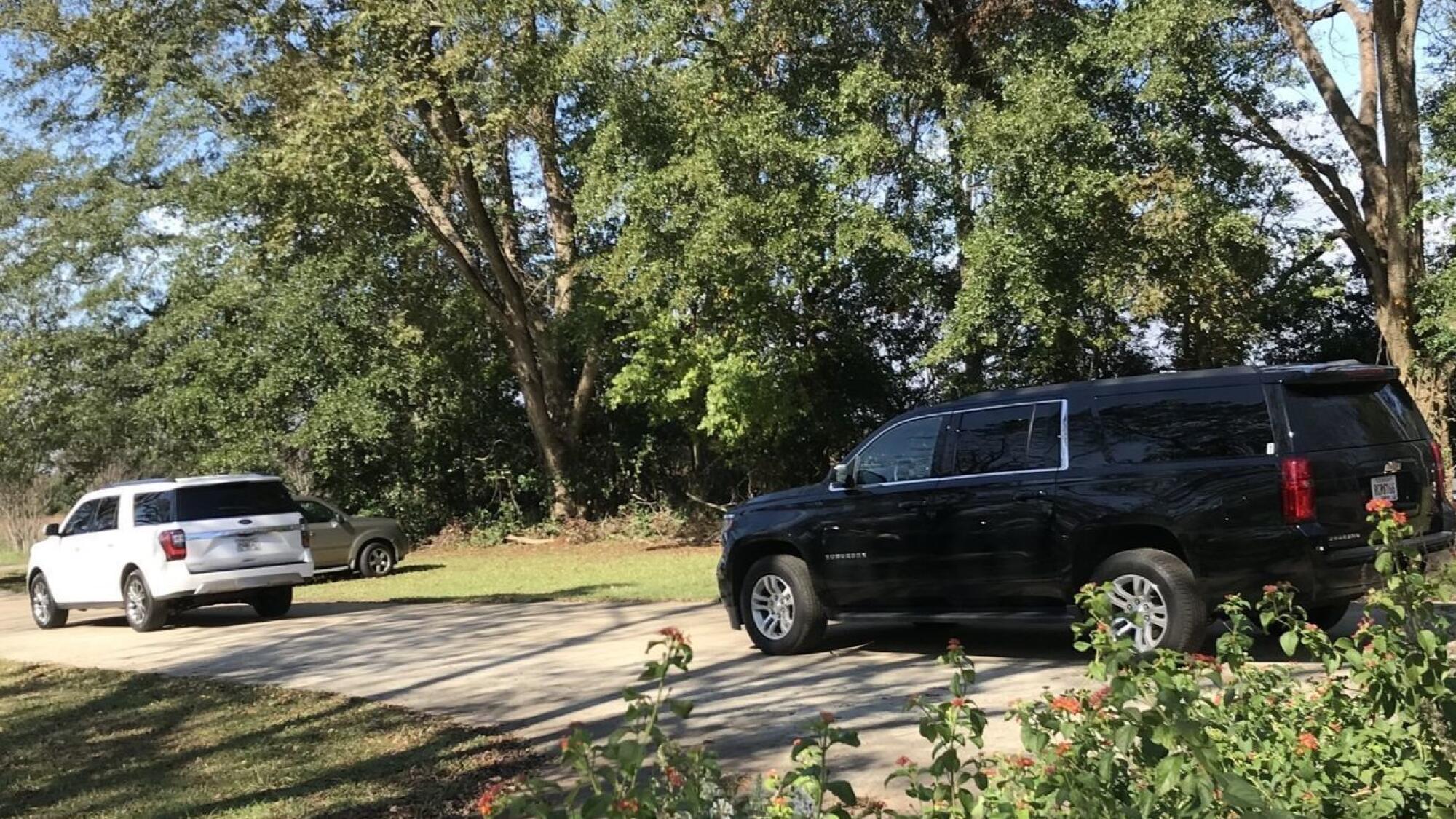
Follow @RandyLewis2 on Twitter.com
For Classic Rock coverage, join us on Facebook
More to Read
The biggest entertainment stories
Get our big stories about Hollywood, film, television, music, arts, culture and more right in your inbox as soon as they publish.
You may occasionally receive promotional content from the Los Angeles Times.

